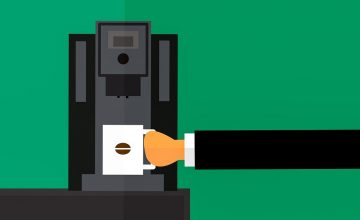Decaf Coffee: Why You Should Never Drink It
- Feb 29, 2016
- By Bev Da Silva
- In Coffee Academy
Decaf Coffee: Why You Should Never Drink It
I can imminently sense that I have already trodden on a few toes, so why not go all the way! How to drink decaf coffee: Throw it in the bin. I’m sorry to anyone reading this who might be a decaf coffee drinker, but you might just thank me once you’ve read it. I get it, really, I do fully understand that there are people who enjoy the taste and aroma of coffee, but due to health issues and restrictions they have to stay away from coffee’s active ingredient: caffeine. It’s not the worst thing in the world – but this post is aimed at those who DO have a choice- and are making the wrong one by choosing decaf coffee 🙂 Humour me…
Decaf Coffee: What You Should Know
Honesty from the outset and throughout – decaf coffee is NOT all created equal. There are four main ways to decaffeinate coffee, and I want to explain them below. I’m going to list their health benefits, risks and methods and explain to you why non-decaf coffee is a better route to go. Also, a handy point to remember that decaf coffee, by law, only needs to be 97% caffeine-free. That 3% is something to consider if you are using decaf as a lifestyle enhancer or because of medical issues.
How to Decaffeinate Coffee: Option 1 – The Roselius Process
Over at CoffeeConfidential.org they have so aptly described this somewhat archaic decaffeination process. It was invented by a German coffee merchant, Mr. Ludwig Roselius in 1903, and went on to be patented in 1906. According to rumour, the reason behind Mr. Roselius’ relentless quest to remove caffeine from coffee was prompted by his father’s death; they firmly believed that excess caffeine intake is what had poisoned his father and lead him to his deathbed. Anyway, the process he employed to decaffeinate coffee was to steam the coffee beans in a brine (salt water) solution, and then using Benzene as a solvent to extract the coffee. Sounds OK, right? Not a chance! This method was dropped ages ago as Benzene is a known human carcinogen (cancer causing component).
How to Decaffeinate Coffee: Option 2 – Solvent Based Process
This is an umbrella term for two types of decaffeination, explained below:
1) Indirect Solvent Based Decaffeination
In the indirect method, beans are first soaked in hot water for several hours, in essence making a strong pot of coffee. Then the beans are removed and either dichloromethane or ethyl acetate is used to extract the caffeine from the water. As in other methods, the caffeine can then be separated from the organic solvent by simple evaporation. The same water is recycled through this two-step process with new batches of beans. An equilibrium is reached after several cycles, wherein the water and the beans have a similar composition except for the caffeine. After this point, the caffeine is the only material removed from the beans, so no coffee strength or other flavorings are lost.[13] Because water is used in the initial phase of this process, indirect method decaffeination is sometimes referred to as “water-processed”.Sourced from Wikipedia.
“Beans are first soaked in hot water for several hours. The beans are removed and either dichloromethane or ethyl acetate is used to extract the caffeine from the water. The caffeine can then be separated from the organic solvent by evaporation. The same water is recycled through this two-step process with new batches of beans. An equilibrium is reached after several cycles, wherein the water and the beans have a similar composition except for the caffeine. After this point, the caffeine is the only material removed from the beans, so no coffee strength or other flavourings are lost. Because water is used in the initial phase of this process, indirect method decaffeination is sometimes referred to as “water-processed”.
2) Direct Solvent Based Decaffeination
In the direct method, the coffee beans are first steamed for 30 minutes to open their pores and then repeatedly rinsed with either dichloromethane or ethyl acetate for about 10 hours to remove the caffeine. The caffeine-laden solvent is then drained away and the beans steamed for an additional 10 hours to remove residual solvent.[12] Sometimes coffees that are decaffeinated using ethyl acetate are referred to as naturally processed because ethyl acetate can be derived from various fruits or vegetables, but because of the impracticality of gathering natural ethyl acetate, the ethyl acetate used for decaffeination is synthetic. Sourced from Wikipedia:
“The coffee beans are first steamed for 30 minutes to open their pores and then repeatedly rinsed with either dichloromethane or ethyl acetate for about 10 hours to remove the caffeine. The caffeine-laden solvent is then drained away and the beans steamed for an additional 10 hours to remove residual solvent. Sometimes coffees that are decaffeinated using ethyl acetate are referred to as naturally processed because ethyl acetate can be derived from various fruits or vegetables, but because of the impracticality of gathering natural ethyl acetate, the ethyl acetate used for decaffeination is synthetic.”
How to Decaffeinate Coffee: Option3 – The Swiss Water Process
A very cool video explaining this process can be found here. This is a chemical-free decaffeination process, pioneered in Switzerland in the 1930’s, and became commercially viable in 1980. This process stands out from the previously mentioned methods of decaffeination, because it does not directly add chemicals to the beans to extract the caffeine from it. Instead, it relies on solubility and osmosis.
You begin by soaking a batch of coffee beans In piping hot water, thus dissolving the caffeine. The water is drained off and passes through an activated charcoal filter. The charcoal filter only removes large caffeine molecules, allowing the coffee beans’ oil and flavour molecules to pass through it. This leaves you with coffee beans containing no flavour or oils in one tank; and water containing all the good stuff, but zero coffee, in another. The second lot (the flavoured water) is widely known as “Green Coffee Extract”.
Here’s the cool part.
The coffee beans themselves are discarded, and the flavour-filled water is re-used to extract the next batch of beans’ caffeine. Because this water is already at saturation capacity form the previous batch, it is able to effectively remove the caffeine from the next batch of coffee beans without losing the flavour! This is the most popular decaffeination method for organic coffee and will always be marked as “Swiss Water” decaf.
How to Decaffeinate Coffee: Option 4 – CO2 Process
This process has been also referred to as “Liquid Carbon Dioxide Method”, and “Supercritical Carbon Dioxide Method”- but it is technically known as supercritical fluid extraction. The CO2 (carbon dioxide) acts selectively on the caffeine. Water-soaked coffee beans are placed in an extraction vessel. The extractor is then sealed and CO2 is forced into the coffee at pressures of 1,000 pounds per square inch / 70kg per square cm – to extract the caffeine. The CO2 dissolves and draws the caffeine from the coffee beans, leaving the larger-molecule flavour components behind. The caffeine-laden CO2 is then transferred to another container where the pressure is released and the CO2 returns to its gaseous state and evaporates, leaving the caffeine behind. The caffeine is removed from the CO2 using charcoal filters, and the caffeine free CO2 is pumped back into a pressurized container for reuse on another batch of beans. This is a highly popular method as it does not employ the use of chemical additive to the coffee.
Decaf VS Normal Coffee
So, looking at what processes coffee undergoes to have it’s caffeine removed can be an eye-opener. You’ll see that the majority of these processes include some sort of chemical additive, barring the Carbon Dioxide (CO2) and Swiss-Water methods.
Yes, caffeine can have a few negative side effects, but, he chemicals added to your decaf coffee may have more of a harmful impact on you than regular coffee could, any day.
So, unless you’re sure of the decaffeination process of your coffee – and it falls into the safe, chemcial-free category – yes, go for it.
If not, maybe re-think your stance on caffeine VS chemicals!
Please feel free to share your thoughts and comments.
Experience a Rental-Free Coffee Machine Trial Now!
Categories
- 10 Reasons Why It’s Better to Rent an Office Coffee Machine
- Affordable Coffee Machines in 2020
- African Coffee
- Aquaspresso
- Automatic Coffee Machine
- Bean to Cup and Automatic Coffee Machines
- Bean to cup vs Espresso Machines
- bean-to-cup coffee machine
- Bean-To-Cup Coffee Machines
- Best Cappuccino Coffee Machines
- Best Coffee Beans in South Africa
- Best Coffee Beans of 2020
- Best Coffee Machine with a Grinder
- Best Dulce Gusto Coffee Capsules
- Best Industrial Coffee Machines
- Best Restaurant Coffee Machines
- Bianchi Coffee Vending Machines
- Bosch Coffee Machines
- Bosch Coffee Machines: Range Overview
- Bravilor Bonamat Coffee Machine Range
- Bravilor Coffee Machines
- Breville Coffee Machines
- Burr Coffee Grinder
- Buying a Home Coffee Machine
- Buying Coffee Machine on Takelaot
- Capsule Coffee Machines
- Cheapest Coffee Machines of 2020
- Choosing the Right Coffee Machine
- Choosing the Right Coffee Machine in 2020
- Cleaning Your Coffee Machine
- Coffee
- Coffee Academy
- Coffee Beans
- Coffee Capsule Brands
- Coffee Machine
- Coffee Machine Battle
- Coffee Machine Buying Guide
- Coffee Machine Dealer List 2019
- Coffee Machine for Home
- Coffee Machines
- Coffee Machines – Reviews, Guides and Comparisons
- Coffee Machines with Milk Frothers
- Coffee Sweeteners
- Coffee Trends 2019
- coffee vending machine
- Coffee Vending Machines
- Coffee/Hot Chocolate Machine
- Coin Operated Coffee Machines
- Commercial Coffee Machine
- De‘Longhi Coffee Machines
- Delonghi Magnifica ESAM3300
- Different Coffee Machine Types
- Dulce Gusto Coffee Machines
- Health
- Health Benefits of Coffee
- How Much To Spend On a Coffee Machine?
- instant coffee
- Jura Bean-to-Cup Coffee Machine Review
- Jura Coffee Machines
- Jura Machine Cleaning Tablets
- Jura vs. De'Longhi
- Keurig Coffee Machines
- Miele vs. Jura
- Mythos Coffee Machine
- Mythos Dealer List 2019
- Nescafé Dolce Gusto Circolo Coffee Machine
- Nescafe Dulce Gusto
- Nescafe vs. Jura
- Nespresso vs. Dolce Gusto vs. Jura
- Office & Commercial Coffee Machines
- Organic Coffee
- Percolator Coffee Machine
- Philips vs De'Longhi
- Powdered Milk
- Price Review
- Review
- Rheavendor Coffee Machines
- Saeco Brand Review
- Saving Money
- Schaerer Coffee Machine
- Starbucks vs. Jura Coffee Machines
- The Best Combo Machine of 2020
- The Perfect Home Coffee Machine
- The Rise of Self-Cleaning Coffee Machines in 2020
- Top 5 Coffee Machine Brands of 2020
- Top Home Coffee Machines
- WMF Coffee Machine Dealer List 2019
- WMF Coffee Machines








